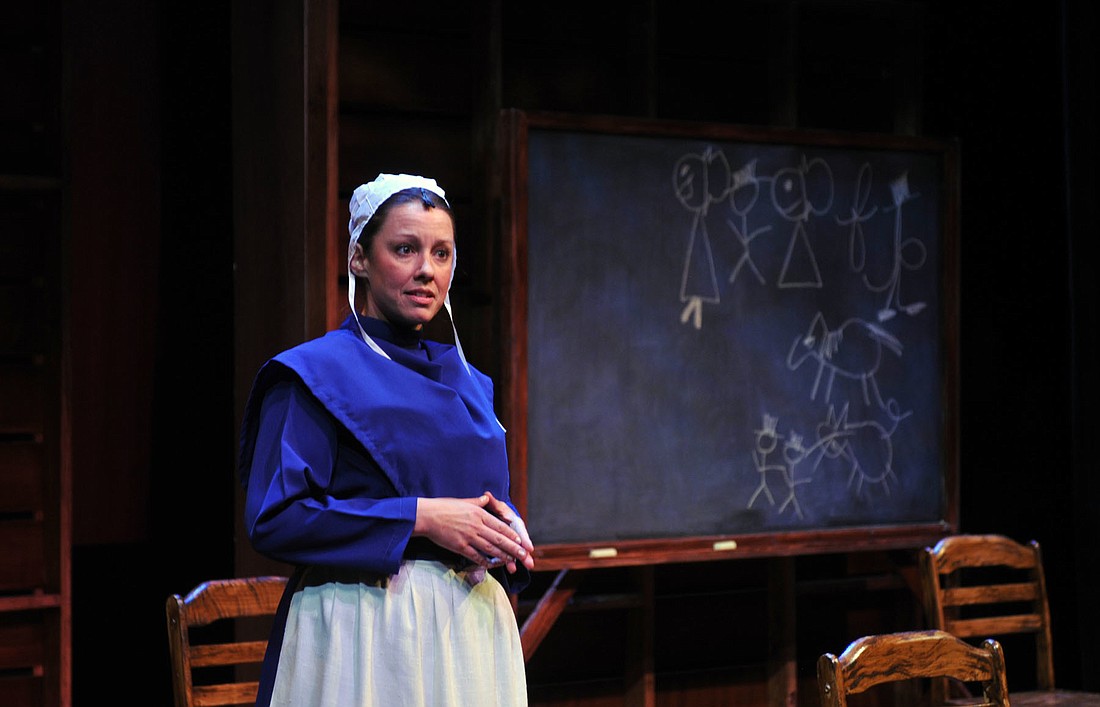- April 19, 2024
-
-
Loading

Loading

“Man enters Amish schoolhouse and opens fire.” That cold headline is the set-up for Jessica Dickey’s “The Amish Project,” the latest Banyan Theater production. Dickey’s play is fiction, but it’s based on a real horror: the 2006 school shooting in Nickel Mines, Pa. The bare facts? A gunman shot ten Amish schoolgirls in a one-room schoolhouse before killing himself. Five of the girls died.
Under Todd Olson’s brilliant direction, Katherine Michelle Tanner brings this remote tragedy home in a sometimes harrowing, sometimes inspiring one-woman performance. She plays all seven parts, including Anna, a six-year-old Amish girl who died in the shooting; Velda, another victim; Bill North, a university professor; Sherry Local, a prejudiced, non-Amish “local” resident; America, an ebullient Latina teenager who works in the local grocery store; Eddie Stuckey, the gunman; and the gunman’s widow, Carol. Tanner flows effortlessly from character to character without a hitch or flubbed line. As a voice character actor, Tanner rivals Mel Blanc or Tracy Ullman. But she’s more than just talk. She gets into the skin of the characters; her physicalization morphs from the bouncy exuberant little girl to the chain-smoking, guilt-ridden widow of the killer, to the finger-popping Latina who extends grace to the poor woman.
Grace is the point, not slaughter. Dickey’s play could easily been exploitive. Instead, it’s improbably sweet, with a focus on the inner lives of the characters. Her play’s structure resembles Quentin Tarantino’s not-so-sweet “Reservoir Dogs.” We cut from person to person, but never see the horrific shooting directly. “The Amish Project” flows around the bloody scene. It shows us the impact on specific individuals instead.
That’s a tough assignment when one actor’s playing every part. But thanks to Tanner’s amazing talent under Olson’s fluid, cinematic style of direction, this oblique structure works. The good, bad and ugly — she makes you believe in them all. Each character stands out and stands apart. And you’re pulled into their very different realities.
So, Tanner starts the action with Velda, who bops around the stage with girlish glee, drawing pictures of friends, family, animals and letters on the blackboards. She morphs into the shattered widow, who’s gob-smacked, not only by her husband’s evil, but the absurdity of the Amish people’s relentless forgiveness. (They even stocked her refrigerator!) Tanner gives us a glimpse of the dead-eyed killer, who informs us from the gitgo, “I’ll tell you right now, I ain’t gonna say ‘why.’ You don’t get that.”
The play’s not going to solve the mystery of evil, in other words. Why do bad things happen to good people? Job didn’t get an answer. Neither do you. Instead, Dickey tackles a deeper conundrum: the mystery of good. As Carol says, “How can the Amish forgive such a thing?” Their forgiveness seems superhuman — or inhuman — to her. Then, at one point, an Amish man speaks a word to Carol. The word remains a mystery. But you know it’s a word of grace. It’s written on her face.
Dickey’s mystery play unfolds on Don Laurel Johnson’s minimalistic set — just a wooden partition, two blackboards and six chairs. Tanner constantly rearranges the chairs to serve the needs of the scene, creating hypnotic permutations in the process. The actor is dressed in Cristy Owen’s traditional Amish grab of white bonnet, apron and blue cotton dress. A single costume — but your mind’s eye dresses her according to the character after awhile. Michael Pasquini understated lighting design is also perfect for this theater of the mind. He stays in the background — except for moments of stunning epiphany, like the sudden sight of an enormous full moon against twinkling stars.
It all adds up to a powerful evening of theater — a surprisingly warm and touching evening, granted the horror at the play’s heart. “The Amish Project” offers no fortune cookie answers to the problem of evil. It suggests some people may have found it.
And maybe that’s enough.